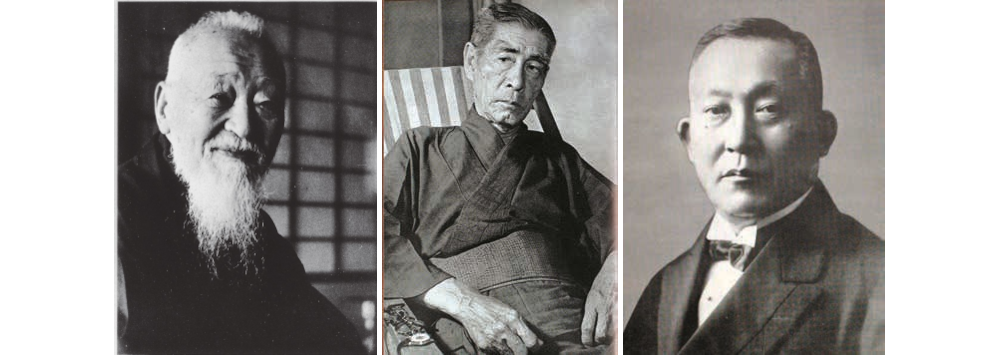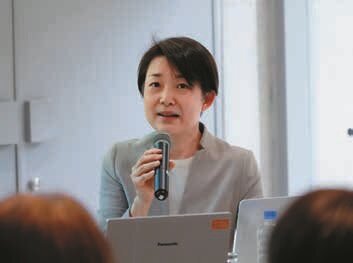Naoshima New Museum of Art Pre-Talk Vol.1
"From Individual Facilities to a Group of Museums;
The Past and Future of Benesse Art Site Naoshima"
-
Index
"The self" as an Ignition Point
by Mari Hashimoto
-
Ms. Osaka and Mr. Kurakata gave talks on Benesse Art Site Naoshima, while mine will focus on its prehistory. The activities of Benesse Art Site Naoshima take place in our current time, but what I would like to speak about is how there were similar activities conducted in the past and how they influenced the art of the times. The axis of my talk will be "the self" as an ignition point. In other words, on how the enormous energy radiated from the passion and ambition of "the self" could influence art.
Japanese culture before World War II tended to be influenced by the personal will and taste of "the self." "The self" as such was most likely sukisha (wealthy lords or merchants who were often tea ceremony masters) and collectors. Collectors of tea ceremony utensils were well known for their strong personalities while there were also notable collectors of other genres. Jian Matsunaga, a powerful industrialist also known as the "Demon of Electricity," Donno Masuda, a prominent leader of the Mitsui financial clique, and Sankei Hara, the owner of the Tomioka Silk Mill. These prominent sukisha were active during the period from the second half of the Meiji era until the Taisho era (approximately from the 1890s - 1910s), following after their predecessors of the early Meiji era, such as Kaoru Inoue and Takuma Dan.
These wealthy leaders of the modern world of business who were also sukisha built prominent collections in Japan that became the foundation of now famous private museums, such as the Gotoh Museum, Hatakeyama Memorial Museum of Fine Art, Idemitsu Museum of Arts, Mitsui Memorial Museum, and Seikado Bunko Art Museum, among others. Some of these collections were built over several generations while others were established by those who became wealthy overnight. The unique characteristics of private museums dissimilar to public ones were nurtured by individual sukisha collectors whose backgrounds were diverse.
From left: Portraits of Takashi (Donno)Masuda, Yasuzaemon (Jian)Matsunaga, Tomitaro(Sankei) Hara
Authority: National Diet Library, JapanThe use of the word "suki" of sukisha, derived from an unusual level of liking or passion for particular objects, appeared around the first half of the medieval period (approximately 11-12th century) of Japan. It initially referred to an unusually strong attachment to poetry (waka) but later came to signify avid followers of tea ceremony and other traditional arts such as flower arrangement and other various hobbies in the late medieval period.
The energy derived from such first-person enthusiasm sometimes gained an enormous amount of power that could cause a major reformation. There was a historical moment that affected the private collections based on the capacity of "the self": the anti-Buddhism movement in the Meiji era (from 1868). On March 28, 1868, the Meiji governmentʼs Great Council issued the ordinance for "Separation of Buddhism and Shinto," which demanded to convert Buddhist terminology to that of Shinto, to call Buddhist deities by the names of Shinto gods, and also to prohibit Buddhist gongs and bells installed in Shinto shrines. While commanding to ban Buddhist-Shinto syncretism and eliminate Buddhist elements from inside and outside of Shinto shrines, the ordinance had no mention of the destruction of Buddhist temples or statues and images. Nevertheless, extreme destruction took place in many places across Japan. As a result, Tenshin Okakura and others had to strive to create the law ordering "Protection of Old Shrines and Temples." Consequently, tea ceremony utensils and Buddhist art were reevaluated during the late years of the Meiji era. This reevaluation would inevitably involve academics, but prior to that, private collectors (sukisha) had gathered up and reappreciated these cultural objects by reintegrating them into new contexts.
The value of Buddhist paintings and sculptures rose the most, for sukisha reevaluated them as genuine fine art and objects of appreciation separate from religion. For instance, they used Buddhist objects to decorate their tea ceremony rooms, presenting a new context of evaluation detached from religious faith - which was an act of curation.
Left: The Peacock Wisdom King, 12C, collection of Tokyo National Museum, national heirloom (former collection of Sankei Hara) Middle and Right: Rinshunkaku, Sankeien Hoshokai Public Interest Incorporated Foundation, ICP
Authority: ColBaseThe trend of art that continued from the Momoyama period until the early Modern period (16-19th century)ranging from painting to crafts was named the Rinpa school after the Meiji era. This was precisely an example of "reevaluation," which was conducted and sponsored by Sankei Hara. Hara created Sankeien Garden endowed with scenic ponds in Yokohama by the seacoast back then. In a city that had just been developed since Modern times with few cultural facilities, he relocated old Buddhist architecture such as Tomyoji Temple Three-storied Pagoda (Muromachi period) from Kyoto, Tokeiji Temple Butsuden (Early Edo period) and Rinshunkaku (Early Edo period), which had been the Kishu Tokugawa Familyʼs summer house, among others, to construct a completely different world.
Around the same time, villas with gardens and tea houses, such as Donno Masudaʼs Soundai in Odawara and Tokuan Nomuraʼs Hekiunso in Nanzenji Temple, Kyoto were also created in addition to Sankeien Garden. These collectors used and showed items of their collections in various ways, and as one of them, held tea ceremony parties. Not all of such social gatherings were closed to the public. For example, Daishikai was one of the big tea parties that represented the time with a large number of attendees like Koetsukai in Kyoto. Masuda hosted the party in Tokyo when he acquired antique objects related to Kobo Daishi (8-9th century Buddhist priest) and continued it in different locations such as Sankeien, Hatakeyama Memorial Museum of Art, and Gokokuji Temple. Since 1974, it has been continued in the Nezu Museum.
At the beginning, Daishikai took place in large sites that had several tea houses and aimed to show the objectsand utensils arranged in the tea rooms to guests. Tea and sweets were served in other houses. Oyose (a large number of attendees) style tea ceremony as such was established around this time. We can perhaps consider this new style that had been never seen until then as a parallel to present-day exhibitions. The sukisha in Meiji thus began to host tea parties inviting a large number of people to see and experience the items of their collections instead of showing their treasured utensils only to a few guests.
Sankei Hara, the creator of Sankeien Garden, was a patron of Yukio Yashiro, an art historian who was reconstructing the history of Japanese art by adopting the discipline of Western art history. Soan Takahashi, who built tea houses in Gokokuji Temple, which is now revered as a mecca of tea ceremony, compiled Taisho Meikikan, a comprehensive catalog of the masterpieces of tea utensils.
One sukisha endeavored to modernize Japanese art history in cooperation with Academism; another intended to reassess the values of tea utensils by compiling the documents in a book; and a third patronized his contemporary nihonga painters
Such examples in early modern times in Japan show that there were endeavors that preceded and were similar to Benesse Art Site Naoshima. The personal passion of "the self" was indispensable. Thus, I conclude by saying that it is exactly this passion of "the self" that has fueled the activities of Benesse Art Site Naoshima.
-
Mari Hashimoto

Mari Hashimoto is Director of the preparatory office for the Kankitsuzan Museum of the Odawara Art Foundation and a visiting professor at Kanazawa Institute of Technology. She holds various roles including writer, curator, art consultant, and makes appearances on art programs for television. She has authored Kazaru Nihon [Japan Adorns](Iwanami Shoten), Bijutsu de Tadoru Nihon no Rekishi [Reading Japanese History through Art] (Chobunsha), Kyoto de Nihon Bijutsu o Miru(Kyoto Kokuritsu Hakubutsukan) [Looking at Japanese Art in Kyoto (Kyoto National Museum)](Shueisha Creative), co-authored Sekai o Kaeta Shomotsu[Books that Changed the World](Shogakukan)and edited and contributed to Nihon Bijutsu Zenshu Vol.20 (Shogakukan).

